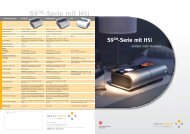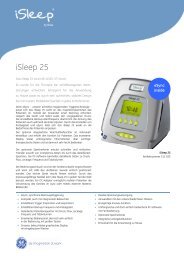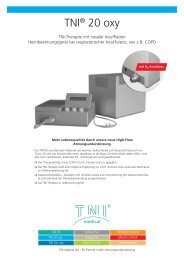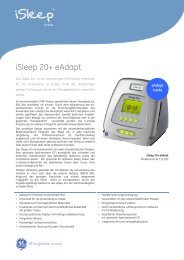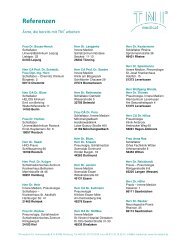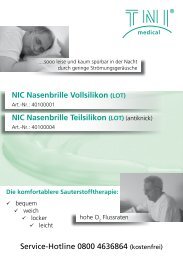Download Product catalogue - TNI medical AG
Download Product catalogue - TNI medical AG
Download Product catalogue - TNI medical AG
You also want an ePaper? Increase the reach of your titles
YUMPU automatically turns print PDFs into web optimized ePapers that Google loves.
<strong>TNI</strong> ® Studies<br />
Therapy<br />
Diagnostics<br />
McGinley,Patil,Kirkness,etal.:ObstructiveSleepApneaTreatment 199<br />
TABLE 3. SLEEP CHARACTERISTICS AND AROUSAL INDICES<br />
Baseline <strong>TNI</strong>,20L/min<br />
Mean SEM Mean SEM pValue<br />
TST,min 317.9 26.0 326.7 12.3 0.64<br />
Sleepefficiency,% 79.5 5.2 85.5 3.3 0.24<br />
NREM,%TST 84.2 1.9 87.2 2.6 0.43<br />
Stage1,% 12.7 3.1 13.2 4.0 0.56<br />
Stage2,% 65.2 4.0 68.2 4.2 0.56<br />
Stage1,% 6.3 1.8 6.3 1.8 0.84<br />
REM,%TST 14.1 2.2 12.8 2.6 0.87<br />
Arousalindices<br />
Respiratory 18.3 3.7 8.3 1.5 0.005<br />
Spontaneous 3.4 2.2 3.1 0.4 0.65<br />
Total 21.6 3.6 11.4 1.5 0.007<br />
Definitionofabbreviation:NREM �non–rapideyemovement;TST �totalsleep<br />
time.<br />
Groupdataarepresentedforboththebaselineandclinicaltreatmentnight<br />
with<strong>TNI</strong>at20L/minute.<br />
CPAPpressureapplied(25).<strong>TNI</strong>atarateof20L/minuteled<br />
toasimilarincreaseininspiratoryairflow(45ml/spercmH2O).<br />
Thepeakinspiratoryairflowsofourpatientsduringhypopneas<br />
wereonlymildlyreducedtoapproximately230ml/second,and<br />
rosetoapproximately300ml/second,alevelpreviouslyassociatedwiththeeliminationofinspiratoryflowlimitationandstabilizationofbreathingpatterns(25).Thus,improvementsinpeak<br />
inspiratory airflow were likely due to increases in pharyngeal<br />
pressure,whichwereofsufficientmagnitudetotreathypopneas<br />
wheninspiratoryairflowlevelsareonlymildlyreduced.<br />
Effect of <strong>TNI</strong> on Sleep-disordered Breathing<br />
Althoughweexpectedmarked improvementsintheAHI primarilyinpatientswithhypopneasratherthanobstructiveapneas,<br />
<strong>TNI</strong>loweredtheAHIinallsubjects,regardlessoftheapnea–<br />
hypopneadistribution.Althoughtheprimarymechanismofactionappearstoberelatedtoincreasesinend-expiratorypharyngeal<br />
pressure, other factors may have further improved<br />
ventilationinadditiontoalleviatingupperairwayobstruction.<br />
First, even small increases in pharyngeal pressure may have<br />
increasedlungvolume.Increasesinlungvolumeleadtoimprovementsinbothoxygenstoresandupperairwaypatency(26–30),<br />
both of which may further stabilize breathing patterns during<br />
sleep.Asventilationimprovedinourpatientsduringsleep,enhancedsleepcontinuity(decreasedarousalfrequency)mayhave<br />
also contributed to further reductions in the apnea–hypopnea<br />
indices(31,32).Indeed,wefoundatrendtowardimprovement<br />
in sleep stage distribution in all subjects, with a reduction in<br />
respiratory arousals, and no change in spontaneous arousals.<br />
Additional benefitsmay have accruedfrom insufflatingairdirectlyintothenose,whichmayproduceconcomitantreductions<br />
indead spaceventilation. Therefore,improvements inoxygen<br />
stores, ventilation, and sleep continuity, along with enhanced<br />
upper airway patency,are likely responsibleforthe beneficial<br />
responsesto<strong>TNI</strong>.Weacknowledgethatobstructivesleepapnea<br />
was not completely eliminated in all of our patients, and that<br />
nasalCPAPmightstillbemoreefficaciousinreducingtheAHI<br />
duringtreatmentnights.Nevertheless,reducedcompliancewith<br />
CPAPcansignificantlycompromiselong-termtherapeuticeffectiveness,leavingasignificantportionofpatientsuntreatedovertime(33).PoorCPAPcompliancehasbeenattributedtocumbersome<br />
masks, and to difficulties in exhaling against a high<br />
backpressure (17). In contrast, <strong>TNI</strong> offers a simplified nasal<br />
interfacefordeliveringrelativelylowlevelsofpharyngealpressure,<br />
which may enhance long-term compliance, and overall<br />
therapeuticeffectiveness,andthusmightreducelong-termcardiovascular<br />
and metabolic complications of obstructive sleep<br />
apnea.<br />
Limitations<br />
Thereareseverallimitationsinthecurrentstudy.First,weused<br />
onlyflowratesof10and20L/minuteinourstudy.Itispossible<br />
thathigherflowrateswouldhavebeenevenmoreeffectivein<br />
eliminatingallrespiratoryevents.However,weusedrelatively<br />
lowflowratestobalancethecomfortofnasalinsufflationwith<br />
efficacy.Indeed,therewerenoreportsofsignificantdiscomfort<br />
orsideeffectsafterafullnightoftreatmentwith<strong>TNI</strong>at20L/<br />
minute,withtheexceptionofreportsthatairtemperatureswere<br />
either too warm (n � 2) or cold (n � 1) for initiating sleep.<br />
Nevertheless, the majority of subjects did not have difficulty<br />
initiatingormaintainingsleepascomparedwithbaseline.None<br />
ofthepatientscomplainedaboutnoiserelatedtotheuseof<strong>TNI</strong>,<br />
whichweacknowledgemightresultfrompatientmotivation,or<br />
perception relative to their previous experience with CPAP.<br />
Moreover,assessmentofsleep architecturebetweennightson<br />
and off <strong>TNI</strong> indicates a trend toward improvement, without<br />
changeinspontaneousarousalindices.Second,itispossiblethat<br />
the cannula may have dislodged during the night, accounting<br />
forthetreatmentfailureinatleastonepatient.Althoughitis<br />
not yet clear how a minor dislodgement of the cannula can<br />
affectefficacy,thefactthatthemajorityofourpatientshada<br />
substantialreductioninsleep-disorderedbreathingindicessuggeststhattheexactpositionofthenasalcannulaisnotcritical.<br />
Third, the occurrence ofapneas might be dependenton body<br />
position. We accounted for body position between the two<br />
nights, thus eliminating the impact of achange in position on<br />
thetreatmenteffect.Fourth,<strong>TNI</strong>wasusedforonlyonenight.<br />
Althoughpatientsdidnotreportanydiscomfortwhenusingit<br />
foronenight,theresponsemightbedifferentwhenusing<strong>TNI</strong><br />
repeatedlyoverseveralnights.Furtherstudiesof<strong>TNI</strong>administeredoverseveralnightswouldberequiredtoexamineitseffect<br />
relative to CPAP. Fifth, assessment of both spontaneous and<br />
respiratory arousals is potentially associated with poor agreementbetweenscorers.Alldatainthisstudywerereviewedby<br />
twoexperiencedboard-certifiedsleepphysicians(H.S.andS.P.).<br />
Toassessqualityassuranceofourscoring,theinterraterreliabilitywasanalyzedforasubsetofpatients(n�9),andwascomparabletopreviousassessmentsofinterraterreliabilityofbothspontaneousandrespiratoryarousalindices(ICC,0.72;95%confidence<br />
interval:0.44,0.88)withexperiencedfull-timescorers(34).<br />
Implications<br />
Thereareseveralclinicalimplicationsofourfindings.First,our<br />
findingsprovideevidencethat<strong>TNI</strong>mayofferaviabletreatment<br />
alternativetopatientswithobstructivehypopneasandapneas.<br />
Thefindingthat<strong>TNI</strong>alleviatedobstructivehypopneasinallbut<br />
onepatientpredictsahighlikelihoodoftreatmentsuccessina<br />
similarpatientpopulation.Aretrospectiveanalysisofourpatient<br />
database with 4,746 patients with obstructive sleep apnea–<br />
hypopneasyndromestudiedbetween1981and2000,whoseAHI<br />
was greaterthan10, showedthat28.4% ofthese patients had<br />
predominantly obstructive hypopneas (more than 90% of all<br />
events) and would meet the polysomnographic and anthropometriccharacteristicsofourstudypopulation.Second,ourfindings<br />
that <strong>TNI</strong> also had an effect on obstructive apnea in our<br />
patientswithanapneaindexofgreaterthan15impliesthat<strong>TNI</strong><br />
may be beneficial in some patientswith obstructive apneas as<br />
well.Furtherstudiesarerequiredtoelucidatethepolysomnographicand/orclinicalpredictorsofa<strong>TNI</strong>response.Third,we<br />
usedafixedflowrateandcannulasize,whichmayobviatethe<br />
needfortitrationstudies.Indeed,itmaybepossibletoofferan<br />
49




